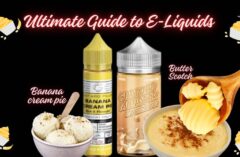Table of Contents
Last Updated on March 31, 2016 by Team Spinfuel
Temperature Control Vaping: The Decision Is Yours
If you’ve been considering a temperature control mod but have yet to pull the trigger, this article, I hope, will give you some valuable information you need to help you make a wise decision, either way. Temperature Control Mods are not everyone’s cup of tea, but if you want to kick your vaping up a notch this is a sure fire way to do it.
Some vapers believe that temperature control mods are the future of vaping. Others disagree, insisting that the benefits of using a TC mod do not yet outweigh the hassle of the learning curve, the rewiring of your brain to think more about temperature than wattage or voltage, or the expense of switching to a new TC-capable mod, coil heads, wires, etc. Not to mention the unwanted limits on cloud chasing. Well, for me it was one of the best things to happen to vaping since the advent of the sub-ohm tank itself. Let’s take a look at where we were in 2014 and where we are today…perhaps even get a glimpse of tomorrow as well.
Before Temperature Control
Years before TC (Temperature Control) technology was a thing, vaping was all about voltage and wattage. Then came variable voltage and wattage, and people began to think in terms of lower ohms, then lower ohms and higher wattage, and so on. All coils, whether they reside in a coil head or used in an RBA or RDA, were always made with Kanthal wire. To this day Kanthal wire is the most stable wire for vaping coils because its resistance is fixed no matter the temperature at which it is used in an RDA or coil head.
As we moved closer to TC Year Zero things got pretty sophisticated… what with the fancy 510-thread tanks with Kanthal wire sub-ohm coil heads, variable high wattage box mods, and high VG e-liquids…things were good. Very good.
Fine-Tuning The Vape Before TC
Fine tuning your vaping experience was, is, a fully realized concept with Kanthal coils. Maximizing flavor and vapor was/is in full swing, so it’s not as though Temperature Control technology was something on people’s minds. Not many vapers even anticipated temperature control before the Evolv DNA 40. Now a TC mode is a feature on nearly every vaping instrument released today as well as the past several months.
Not only do most of the newer regulated mods ship with TC circuitry, but now high-end sub-ohm tanks are shipping with Ni200 (Nickel) and/or Titanium and Stainless Steel coils in the coil heads. You can’t get away from it even if you tried. So, it begs the question; “What’s the big deal? Why try to fix something that isn’t broken?”
Well, in a way, it is broken. Right before Temp Control was unleashed on the vape crowd we were running up against regulated variable high wattage devices and super low resistance, sub-ohm coil heads in our tanks and RDA’s. We were approaching, and exceeding, the lowest safe resistance for Kanthal wire-based tanks and RDA’s. The results of which were somewhat worrisome.
A Dry Hit in A Sub-Ohm World
The nasty, mean, ugly experience of taking a lung hit off a sub-ohm tank that happened to not have enough e-liquid in the cotton wicking and coils is a horrendous experience. And, the higher the wattage in our devices, and the lower the resistance in our Kanthal sub-ohm tanks, the more often these dry hits were occurring.
No one was used to vaporizing e-liquid as quickly as a 0.3-ohm Kanthal sub-ohm tank vaped at 44watts could do.
Taking a full on lung hit on a full sub-ohm tank with a 0.3-ohm Kanthal coil head sitting atop a high wattage box mod set to 40-45w with your favorite e-liquid is something that can only be experienced to be appreciated. Simply put, it is splendid! There is nothing like it in all of Vapelandia.
Taking one-too-many lung hits is the very opposite experience. It kills the mood, burns your throat, ruins a coil head, scorch’s the cotton wicking, and just plain pisses you off like nothing else can. It hurts, physically and emotionally. You feel stupid, its totally your fault for not keeping an eye on the e-liquid level in the tank, and it was supposed to be easily avoided. Worse? It doesn’t happen just once. It happens even when you think you’re being careful.
The truth is vapers and manufacturers cared more about higher wattage and lower ohms resistance long before temperature control tech came on the scene.
Temperature Control to The Rescue
Temperature Control Technology fixes that problem…as long as you use it properly. Once you’re using it like you should you’ll never have to worry about dry hits again… with an added bonus of using less e-liquid and enjoying a longer battery life. So, using temperature sensing technology is something you might want to consider, if you haven’t already.
How Does Temperature Control (Sensing) Work?
Temperature Control (sensing) works by simply monitoring the changes of resistance in a coil and using these changes to estimate temperature changes. It is successful because resistance increases are undeviating and anticipated with temperature changes, though the amount of the increases varies greatly between the different wires that are used. For more on that, see our advanced article in the Knowledge Base for Coil Wire Coefficients.
I could get pretty advanced here talking about the various coefficients in different metals, but as long as you are using sub-ohm tanks there is no reason to complicate matters. So the better question might be:
Controlling Temperature Control
Temperature Control allows you have far more control on your vaping experience than you can without it. Everyone has vaped a flavor of juice that was great, but always seemed to be a just a bit off from the real thing.
For example, I love bakery type flavors, but no matter how I built my coils in my RDA, or used a fresh coil head in a sub-ohm tank, or for that matter, changed my wattage and voltage to find the sweet spot, it always seemed a bit off, with Kanthal wire.
But even with TC coil or coil heads, when I filled a tank and set it to 500-550 degrees, it to was off. So I just turned the temp up or down until I hit the sweet spot for that particular flavor in that particular coil build. Sounds pretty much the same amount of work to find the sweet spot, doesn’t it?
And that’s the thing; controlling your vape with TC tech is a lot like controlling your vape without TC tech. It might be easier to adjust the temperature, but there are other benefits to the temperature control we’ve yet to look at.
The Same…Yet Not the Same
If an advantage of temperature control is the ability to tailor make your vape experience using an up or down temperature change, then variable wattage and variable voltage pretty much does the same thing, yes?
Back when variable wattage began getting really popular over the alternative of variable voltage, people pointed out that variable wattage can accomplish the same thing, so why bother learning something new.
Some vapers, including myself, saw variable wattage as the definitive vaping experience, being superior to variable voltage. But, what really happens when adjustments are made to variable wattage devices? It adjusts the voltage as well. The truth is, as I discussed in my ‘Taking the Mystery out of Variable Wattage’ piece, it is the same thing. You can’t adjust both variables, its one or the other. Do these similarities occur with temperature control vaping?
Yes, and no.
Setting up a TC vape you set the temperature lower and it lowers the voltage. When using a variable wattage device, you set the wattage lower and it lowers the voltage…again.
What makes a Temperature Control device different is that you can deliver a constant temperature to your vape experience so you get a constant vape regardless of the resistance changes in a coil. While a variable wattage device gives significant control over your vape, if you vape like me, in other words, heavy vaping, variable wattage consistency can change.
Using Temperature Control keeps the temperature constant regardless of how often you vape. TC Mods do a great job at maintaining a quality vape experience no matter how or how long you’re vaping. This is a real game-changer for pacify vapers.
Adjusting the temperature with a Nickel, Titanium, or Stainless Steel coil, you have more control over the flavor than you do while vaping with a Kanthal wire tank or RDA.
Temperature Control mods often have a maximum temperature setting between 540 and 600 degrees, and no matter what, it will adjust the wattage on the fly so that your vape stays at that temperature the entire time. One of the properties I like about Stainless Steel wire, in an RDA or sub-ohm tank, is that it “ramps up” in a near instant, so you reach your set temperature as fast as possible. With Kanthal wire, the resistance hardly rises at all, even with massive amount of heat, so the longer you hold down the fire button the hotter it gets. Not good.
While I do use Kanthal wire and sub-ohm coil heads often enough, I’ve found that when I am using an Evolv DNA– equipped mod, either the DNA 40 or DNA 200, I enjoy the vape with Nickel wire (Ni200) more than I do Kanthal, despite the properties of Nickel making the act of building coils a hassle sometimes. The flavor is about the same as Kanthal, but it is a little cleaner, and there is never a worry about overheating the coils. UPDATE: Evolve, the DNA 40 and DNA 200 manufacturer has made a recent firmware and eScribe update for the DNA 200 that has
the coefficients for titanium and 316 stainless Steel wires, so you can now vape with these wires under their Temperature Control/Sensing mode.
Keeping It Healthy
If you are ever worried about any harmful compounds and chemicals that your e-liquid may contain, such as DA/AP/BA, using a Temperature Control Mod can help.
Whereas in Variable Voltage and Variable Wattage devices, as well as mech mods, when you hit the fire button the coils continue to heat up, which means you could cause the coil to expel vapor that is theoretically harmful to your health, though, in reality, the temperatures we’re talking about are a lot higher than any TC- mod is capable of.
Temperature Control stays at an even temperature, at or below the 600 degrees, making it safer to vape because any potential harm comes from twice that temperature. With Temperature Control devices, your mod has a “governor” on it, meaning that when you fire it you are limited to how high or how hot your mod can get. But again, I stress that in order for any vapor to cause harm the temperature of the coils has to be a whole lot hotter than what is currently possible with today’s mods.
Bathe in the Warm Vapor… Even with TC Coils
Going over all the previously discussed bennies of Temperature Control, temperature regulation, protection against dry hits, and the like, there is another benefit to TC vaping if you enjoy warm vapor and massive clouds.
Temperature Control can warm the vapor to a nice and toasty temp, but, with its built in governor, a TC mod won’t be winning any cloud competitions. Which is why mech mods are still the competitor’s choice for cloud chasing.
I’ve heard some of my very advanced vaper friends say that TC mods hold back too much vapor, making it less appealing for anyone looking for big clouds. While I agree that a TC Mod is not the one you want use in competitions, they can still create massive clouds of vapor with a High-VG e-liquid and maxed out temperature.
Building Temperature Control Coils
Using Nickel wire for building Temperature Control coils can be aggravating. Nickel is softer, springy, and requires thinner gauges in order to hit the targeted resistance of many devices. But I still prefer it for DNA 200 mods.
Kanthal wire is always the easiest to work with when building coils, but there is also a lot to say about using Titanium and Stainless Steel. In fact, Stainless Steel is as easy to use as Kanthal. However, getting into building various TC coils is beyond the scope of this article. For more than building TC coils, check out our piece on working with Nickel, Titanium and Stainless Steel here.
So while you may sense that vaping with a Temperature Control mod is essentially the same as vaping with a non-TC mod, there is the matter of consistency. By maintaining an even temperature throughout, no matter how often you vape, you will never need to worry about coils getting too hot, expelling any harmful vapor, or causing you to experience the dreaded dry hit.
Tom McBride








